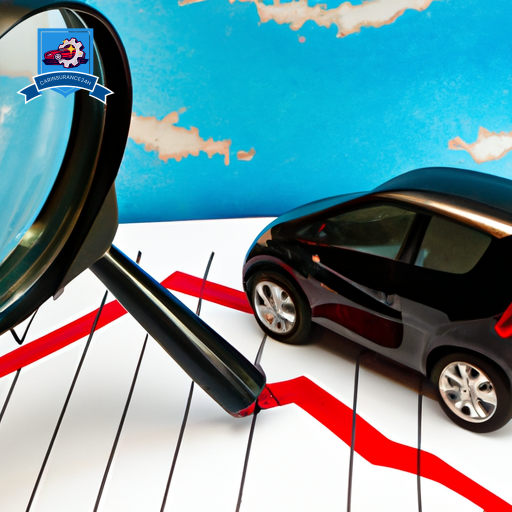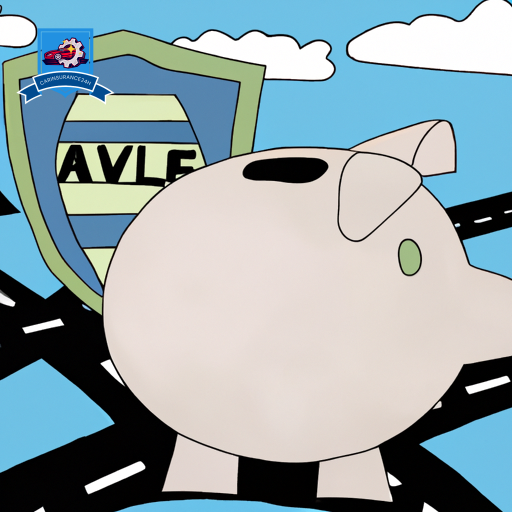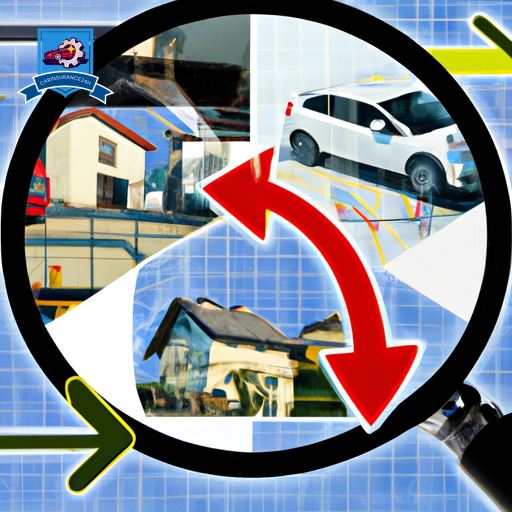The correlation between an individual’s driving history and the determination of insurance premiums is a pivotal aspect of risk assessment for insurance companies. By meticulously analyzing factors such as past traffic violations, accidents, and adherence to road safety regulations, insurers are equipped to assign premiums that accurately reflect the potential risk a driver poses.
This intricate balance guarantees that responsible drivers are incentivized through lower premiums, while those with less commendable records might face higher charges. However, the question remains: to what extent do these historical factors influence the final premium, and are there avenues for drivers to mitigate negative impacts on their insurance costs?
Engaging with this topic further will uncover the nuanced strategies that both insurers and drivers employ in managing the complexities of risk assessment.
Understanding Risk Assessment

Risk assessment, a cornerstone of the insurance industry, meticulously evaluates the likelihood of future claims based on historical driving behavior. This evaluation is pivotal in determining the insurance premiums that drivers must pay. By examining a driver’s historical conduct on the road, insurers can forecast potential risks and adjust premiums accordingly. This process, grounded in statistical analyses and actuarial science, seeks to establish a correlation between past driving behavior and the probability of future incidents.
Moreover, risk assessment extends beyond mere driving history. Factors such as a driver’s credit score and geographic location are also integral to this thorough evaluation. A credit score, often seen as a reflection of an individual’s financial responsibility, is hypothesized to correlate with their driving responsibility. Insurers posit that individuals with higher credit scores are less likely to file claims, hence posing a lower risk. Consequently, these drivers may benefit from reduced premiums.
Geographic location plays an important role in risk assessment due to the variance in traffic conditions, accident rates, and vehicle theft across different areas. Urban areas, with their dense traffic and higher crime rates, often present a higher risk than rural areas. This geographic differentiation allows insurers to tailor premiums more accurately, reflecting the specific risks associated with a driver’s regular environment.
To summarize, risk assessment in the insurance industry is a multifaceted process that combines historical driving behavior with other significant factors like credit score and geographic location to predict future claims accurately. This rigorous analysis ensures that premiums are reflective of the actual risk each driver poses.
Major Factors Affecting Premiums

Several major factors, including driving history, credit score, and geographical location, greatly influence insurance premiums. Insurance companies meticulously analyze these variables to guarantee risk assessment and determine the cost of insuring an individual. This structured evaluation guarantees that the premiums charged are proportionate to the perceived risk of insuring the driver.
| Factor | Impact on Premiums | Why It Matters |
|---|---|---|
| Driving History | High | A history of accidents or violations suggests a higher risk, leading to increased premiums. |
| Credit Score | Medium-High | Insurers view a good credit score as indicative of responsible behavior, potentially lowering premiums. |
| Geographic Location | Medium | Areas with high traffic, theft rates, or natural disasters can see higher premiums due to increased risks. |
| Vehicle Type | Variable | The cost, repairability, and safety features of a vehicle affect its insurability and premiums. |
| Age and Gender | Medium | Statistically, certain age groups and genders are associated with different levels of risk. |
The interplay between these factors is complex. For instance, a high credit score might mitigate some of the premium increases associated with a less favorable driving history. Similarly, living in a high-risk geographic location might be partially offset by driving a vehicle that’s deemed safer or cheaper to repair.
Understanding these factors provides a critical foundation for anyone looking to minimize their insurance premiums. It’s clear that while some elements, like geographic location, might be out of one’s control, others, such as maintaining a good credit score, are within an individual’s power to influence.
Common Violations and Consequences

Within the context of driving history’s impact on insurance premiums, it is important to examine the ramifications of common violations such as speeding tickets, DUI offenses, and the accumulation of minor infractions.
Speeding tickets can elevate risk profiles, leading to incremental premium increases, while DUI offenses often result in severe penalties, including substantial hikes in insurance costs.
Additionally, the accumulation of minor infractions over time can signify a pattern of risky behavior to insurers, potentially resulting in escalated premiums.
Speeding Tickets Impact
One of the most common violations affecting insurance premiums is receiving speeding tickets, which can greatly increase costs due to perceived higher risk of accidents. Speed limits are established to enhance road safety, and exceeding them can result in penalties that affect one’s driving record and insurance rates. However, some insurance companies offer ticket forgiveness programs as an incentive for safe driving behavior over time.
-
Increase in Insurance Premiums: Speeding tickets signal to insurers a higher risk profile, leading to increased premium rates.
-
Ticket Forgiveness Programs: Certain insurers offer forgiveness for the first speeding violation, mitigating premium hikes.
-
Impact on Driving Record: Accumulation of speeding tickets can lead to more severe consequences, including license suspension.
-
Variable Rate Increases: The severity of the speed limit violation influences the rate of premium increases.
DUI: Severe Penalties
While speeding tickets can greatly impact insurance premiums, driving under the influence (DUI) incurs even more severe penalties and consequences for drivers. DUI convictions often result in considerably higher insurance costs, reflecting the increased risk perceived by insurers.
The gravity of DUI offenses is also recognized in the legal system, where individuals may face hefty fines, license suspensions, and even incarceration. Legal defenses against DUI charges might involve questioning the accuracy of blood alcohol content testing or asserting procedural errors.
Additionally, participation in rehabilitation programs can sometimes mitigate penalties, demonstrating the offender’s commitment to rectifying behavior. These measures, however, cannot fully alleviate the long-term financial and legal implications of a DUI on one’s driving history and corresponding insurance premiums.
Minor Infractions Accumulation
Accumulating minor infractions, such as speeding or failing to stop at a stop sign, can incrementally increase insurance premiums and reflect negatively on a driver’s record. Beyond the immediate financial impact, these violations can have long-term consequences.
-
Increased Insurance Premiums: Each violation adds points to a driver’s record, leading to higher insurance costs.
-
Points on Driving Record: Accumulation of points can result in license suspension.
-
Mandatory Traffic School: Multiple infractions may require attendance at traffic school, which can be both time-consuming and costly.
-
Opportunity for Improvement: Enrolling in defensive driving courses voluntarily can mitigate some negative impacts, demonstrating responsibility and potentially reducing insurance rates.
These outcomes underscore the importance of maintaining a clean driving history to avoid unnecessary financial and administrative burdens.
Accidents and Their Aftermath

Accidents and their aftermath play a pivotal role in determining the future of insurance premiums for drivers.
The severity of an accident, alongside the intricacies of the claim filing process, directly influences the magnitude and duration of premium adjustments.
Understanding these components is essential for policyholders aiming to navigate the potential financial impacts following a vehicular incident.
Accident Severity Levels
The severity of an accident plays a pivotal role in determining the aftermath and the resulting impact on insurance premiums. This is influenced by various factors, including accident types and injury reports. Understanding these levels of severity can greatly aid in grasping the complexity of risk assessment for insurers.
-
Minor Accidents: Involving superficial damages with no injury reports.
-
Moderate Accidents: May include minor injuries or significant vehicle damage, requiring professional assessment.
-
Major Accidents: Characterized by serious injury reports, necessitating emergency medical attention and extensive vehicle repairs.
-
Total Loss: The most severe level where the cost of repairs exceeds the vehicle’s value, often accompanied by critical injuries.
Each level impacts insurance premiums differently, reflecting the risk and cost associated with the accident’s severity.
Claim Filing Process
Following an automobile incident, initiating the claim filing process is a critical step that entails a series of structured and detailed procedures to accurately document the event and its repercussions for insurance purposes.
| Step | Description |
|---|---|
| Notification | Immediate reporting of the incident to the insurer, preferably online. |
| Documentation | Gathering and submission of all relevant documents and evidence. |
| Review | Insurer’s assessment of the claim based on the provided documentation. |
| Decision | Communication of approval or denial of the claim, based on policy terms. |
| Settlement & Adjustments | Final settlement and any necessary policy adjustments, including Online Reporting. |
This process guarantees a systematic approach towards claim resolution, emphasizing the importance of Online Reporting and the potential for Policy Adjustments post-claim.
Premium Increase Duration
Understanding the claim filing process sets the stage for comprehending how accidents impact insurance premiums, specifically regarding the duration of premium increases. When an insured party files a claim after an accident, insurers reassess the risk profile of the policyholder, often resulting in increased premiums. However, the duration and extent of these increases can vary greatly based on several factors.
-
Severity of the Accident: More severe accidents typically result in longer periods of premium increases.
-
Policyholder’s Driving History: Individuals with a clean driving record may see shorter increases.
-
Payment Options: Some insurers offer options to mitigate increases through higher deductibles or lump-sum payments.
-
Policy Cancellation: In extreme cases, continuous accidents could lead to policy cancellation, forcing the policyholder to seek new insurance, often at much higher rates.
Improving Your Driving Record

Improving your driving record is an essential step towards reducing insurance premiums and enhancing your overall safety on the road. A driver’s history is a critical factor that insurance companies consider when determining rates. It reflects the risk they undertake by insuring a motorist. A clean driving record indicates a responsible and low-risk driver, which often translates to lower insurance costs.
One effective method to improve a driving record is by enrolling in a defensive driving course. Defensive driving courses are designed to teach drivers safe driving techniques to avoid accidents and traffic violations. These courses not only provide valuable skills but may also lead to the removal of license points in some jurisdictions. License points are added to a driver’s record following traffic violations, and accumulating too many points can result in higher insurance premiums and even the suspension of one’s driving license. Therefore, reducing license points through defensive driving courses can be a direct path to lower insurance rates.
Adopting safe driving habits and adhering strictly to traffic laws are fundamental actions for maintaining a clean driving record. Avoiding speeding, driving under the influence, and distracted driving are critical practices that reduce the likelihood of accumulating license points and traffic violations.
Strategies for Lowering Premiums

Having established the importance of a clean driving record, exploring additional strategies for lowering insurance premiums becomes the next logical step. Beyond maintaining a spotless driving history, policyholders can employ various approaches to potentially reduce their insurance costs. These strategies are grounded in understanding how insurance companies assess risk and reward responsible financial behavior. By adopting certain practices, individuals can present themselves as lower-risk clients, enticing insurers to offer more favorable rates.
Here are four key strategies for lowering insurance premiums:
-
Improve Your Credit Score: Many insurance companies consider credit scores when determining premiums, under the premise that individuals with higher credit scores are less likely to file claims. By paying bills on time, reducing debt, and avoiding new credit inquiries, policyholders can improve their credit scores and, consequently, their insurance rates.
-
Seek Out Policy Discounts: Insurers typically offer a variety of discounts for behaviors that indicate responsible driving or lower risk. This can include discounts for safe driving, the use of telematics programs, completion of defensive driving courses, and having a car equipped with safety features.
-
Bundle Insurance Policies: Purchasing multiple policies from the same insurer, such as auto and homeowner’s insurance, can often lead to discounts on each policy. This bundling strategy is beneficial for both the insurer and the policyholder.
-
Increase Your Deductibles: Opting for a higher deductible can significantly lower the premium cost. This strategy is most effective for drivers who rarely file claims and are financially prepared to cover the higher deductible in the event of an accident.
Frequently Asked Questions
How Do Insurance Companies Verify the Accuracy of My Driving History?
Insurance companies utilize advanced verification technologies to guarantee the accuracy of your driving history, meticulously addressing data privacy concerns. This process involves cross-referencing information with governmental databases and employing sophisticated algorithms for analysis.
Can Moving to a Different State Affect My Insurance Premiums Due to My Driving History?
Yes, relocating to a different state can influence your insurance premiums. State regulations and premium variability play pivotal roles, as each state’s insurance guidelines and risk assessment criteria greatly affect the calculation of your premiums.
How Long Does a Dui/Dwi Remain on My Driving Record for Insurance Purposes?
A DUI/DWI typically remains on a driving record for insurance purposes for 3 to 10 years, depending on state laws. Legal consequences and the possibility of record expungement vary, influencing the duration on one’s record.
Are There Specific Programs or Courses That Can Directly Remove Points From My Driving Record, Thus Affecting My Premiums?
Yes, enrolling in traffic schools or defensive driving courses can directly lead to the removal of points from your driving record. This, in turn, may favorably influence your insurance premiums by demonstrating responsible driving behavior.
How Does a Change in My Vehicle Type or Model Impact My Insurance Premiums if I Have a History of Violations or Accidents?
Switching to a high-performance vehicle can skyrocket your insurance premiums, especially if it lacks advanced safety features. Insurers meticulously analyze vehicle type and model, considering these factors paramount in evaluating risk and determining rates.










